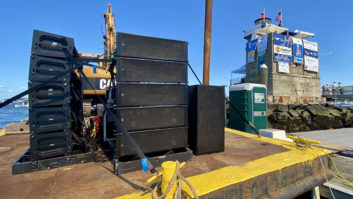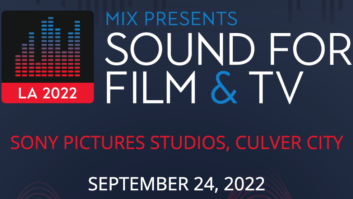
It sounds like a trick question: How do you hold an all-day festival for 7,000 music fans—complete with eight bands, a stage, FOH and monitor mix areas, line arrays and the rest—on a 40×40-foot plot of land that has no electricity?
That’s the conundrum the audio crew faces every year at the annual Huntington Lighthouse Music Fest—an event that takes place every Labor Day Weekend on the eponymous edifice, surrounded by nothing but water in the middle of the Long Island Sound, just east of New York City.

Run for six years by the Huntington Lighthouse Preservation Society, the event raises money to save the still-in-use nautical guide; this year’s show, held September 1, collected funds to restore the building’s Rip-Rap—the boulders that surround lighthouses, keeping the waters at bay. When the castle-like lighthouse was erected 100 years ago, the base was far bigger than 40×40 feet, but time has taken its toll on the rocks, and 650 tons of new rip-rap is needed—at at a cost of $350,000. Having been awarded a $250,000 New York State matching grant (if it raises a quarter-million, it gets another $250,000 from the state), the Preservation Society was out in full force on the beautiful Saturday afternoon, hosting the concert as it collected donations from boaters who had pulled up and moored around the lighthouse to watch the show.
While volunteers were going boat-to-boat dressed as pirates demanding booty (donations), the audio team was hard at work, led by technical director Donald Davidson of HDH Davidson Entertainment, who organized the gear and its transport, hired the bands, and took off an hour to play drums and sing with his group, Blacklight. Also on the crew were FOH engineer Jacob Levitin, monitor engineer Roy Weinberger and numerous deckhands.
Load-in began a day earlier after low-tide—an important consideration when the loading dock is really a dock. The Preservation Society is as scrappy and steadfast as the lighthouse itself; lacking the help of barges or some of the massive luxury yachts parked nearby, every piece of equipment, from Meyer Sound M’elodie line array boxes to the backline to the generators, was brought out in small working boats.
That made for a load-in with an air of improvisation about it—for instance, the Yamaha DM2000 FOH digital console had to be brought out to sea without the top of its case, covered only by a blanket, in order to fit in the watercraft. After the five-minute journey from shore to lighthouse, it then had to be lifted out to the dock and carried up a 3-foot-wide floating ramp.
“That ramp becomes like a ladder at low tide,” laughed Davidson. “The first year, we didn’t know anything about tides. We brought stuff out in the morning and weren’t quite paying attention to how steep the ramp was getting. Then 11 at night, we go to bring it back, and the dock’s three stories in the air above the boat!”
Given the lack of space at the lighthouse, the main mix position was housed under a tent at the base of the building, while bands performed up on the roof of the first floor so that boaters could see them. A pair of groundstacks, comprised of Meyer Sound MSL-2As and USW-1Ps, faced towards the shore on the dock gantry and the base of the lighthouse respectively, while two stacks of four Meyer M’elodie line array boxes each were placed at the top of the lighthouse tower, facing out to the Long Island Sound.
“We have always tried to keep it as small and compact as possible, but each year, it creeps up a little bit more,” said Davidson. “Last year, I went to the back of the lighthouse and said, ‘Whoa, there’s 300 boats back here and I don’t have any speakers for them!’ Now the M’elodies are doing a great job of filling in the back, but that’s not the only reason we chose them: You have to carry them up a spiral staircase, then up a ladder, then through a 30×30” trap door, to get to the railing around the beacon.”

Another expansion this year was the arrival of a digital FOH desk, at the insistence of Levitin, who moved up to the FOH position after helping out as a runner in years past. Drawing on his experience as touring engineer for Brooklyn act Brother Joscephus and the Love Revival Revolution Orchestra, Levitin oversaw 23 inputs from the stage on the Yamaha DM2000, and recorded the bands using Apple Logic Pro. Perhaps the most crucial piece of gear, however, was the screen next to the desk. “We have the video screen so I can see what’s going on up on the stage,” he explained. “It’s so bright out, I can barely see the meter bridge on this desk, so I have to make sure who’s at what mic.”
Along with the upgrades at FOH came another new wrinkle for the Festival—a monitor position. Camped out in a far corner of the stage space near the bands, the previous FOH engineer, Roy Weinberger, oversaw a small Mackie mixer, which made for a big improvement over using fold-back as had been done in previous years. “Having monitors separate has been so much less stressful,” said Levitin. “Last year, I was running back up and down, relaying five different requests—it was tedious. The bands have been playing better as a result this year, too.”

While the event is run on a shoestring budget in order to save as much money as possible for the non-profit’s fundraising efforts, the audio gear has come a long way from the first Festival six years ago. Davidson recalled, “The whole concept was crazy—no electricity, everything had to be carried by boat—but I figured I’d bring out a little bit of stuff, and see how it went. That didn’t work. Second year—OK, I’ll borrow everything from everyone I know. That didn’t work. Then finally we made the jump to Meyers and that simplified everything so much because they’re self-powered. No crossovers, no power amp racks, no power distribution centers. The biggest problem is still the electricity, because we want to get one big generator out here, but it involves barges, permits, cranes, so we have to work with four smaller generators and hope that everything works, and thank goodness it does.”
Throughout the day, the Festival served up a variety of musical styles, from reggae to funk to old-school party rock. “We don’t get ‘Oh we play everything’ bands,” said Davidson. “There’s a hardcore blues band; a surf band; an Earth, Wind & Fire-type horn band that are all schoolteachers who love that sound; my band is Blacklight and we’re all ’60s and ’70s rock. So it’s bar bands, but they’re all in niches that they love and are passionate about.”
The Preservation Society raised about $50,000 from the Music Fest, thanks to donations, ads in the program booklet handed out to boaters, and T-shirt sales. Given the seemingly endless stream of boats that moored up to enjoy a day of sound on the Sound, it seems a good bet that Davidson and his crew will be ferrying all that gear and backline back to the Huntington Lighthouse again next year.
Huntington Lighthouse Preservation Society
www.huntingtonlighthouse.org
Huntington Lighthouse Music Fest
www.lighthousemusicfest.com
HDH Davidson Entertainment
www.hdhdavidson.com
Meyer Sound
www.meyersound.com
Yamaha Commerical Audio Systems
www.yamahaca.com







